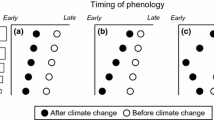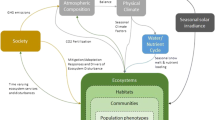Abstract
The analysis of changes in the timing of life cycle-events of organisms (phenology) has been able to contribute significantly to the assessment of potential impacts of climate change on ecology. These phenological responses of species to changes in climate are likely to have significant relevance for socio-economic issues such as agriculture, forestry and human health and have proven able to play a role in raising environmental awareness and education on climate change. This paper presents the European Phenology Network (EPN), which aims to increase the efficiency, added value and use of phenological monitoring and research, and to promote the practical use of phenological data in assessing the impact of global (climate) change and possible adaptation measures. The paper demonstrates that many disciplines have to deal with changes in the timing of life-cycle events in response to climate change and that many different user groups are involved. Furthermore, it shows how EPN addresses issues such as (1) raising public awareness and education, (2) the integration and co-operation of existing observing systems, (3) integration and access to phenological information and (4) communication.

Similar content being viewed by others
Notes
See the websites of both the Dutch (http://www.natuurkalender.nl/) and the UK (http:www.phenology.org.uk/) networks
The GLOBE programme, Natur-detektive, Natuurkalender, Plantwatch, Baltic Sea Project, Ecological Co-operation
References
Ahas R (1999) Long-term phyto-, ornitho- and ichthyophenological time-series analyses in Estonia. Int J Biometeorol 42:119–123
Ahmad QK, Anisimov O, et al (2001) Summary for policymakers. Climate change 2001: impacts, adaptation, and vulnerability. A report of Working Group II of the Intergovernmental Panel on Climate Change. IPCC, Geneva, p 17
Beaubien EG, Freeland HJ (2000) Spring phenology trends in Alberta, Canada: links to ocean temperature. Int J Biometeorol 44:53–59
Begon M, Harper JL, Townsend CR (1990) Ecology; individuals, populations and communities. Blackwell, Boston, p 945
Bindi M, Fibbi L, Gozzini B, Orlandini S, Miglietta F (1996) Modelling the impact of future climate scenarios on yield and yield variability of grapevine. Clim Res 7:213–224
Boer MM, De Groot RS (eds) (1990) Landscape-ecological impact of climatic change. In: Proceedings of a European conference, Lunteren, The Netherlands, 3–7 December 1989. IOS Press, Amsterdam, p 429
Both C, Visser ME (2001) Adjustment to climate change is constrained by arrival date in a long-distance migrant bird. Nature 14:296–298
Butts RA, Lambs RJ (1991) Seasonal abundance of three Lygus species (Heteroptera: Miridae) in oilseed rape and alfalfa in Alberta (Canada). J Econ Entomol 84:450–456
Chmielewski FM, Roetzer T (2000) Phenological trends in Europe in relation to climatic changes. Agrarmeteorol Schr Heft 07:15
Costanza R, D'Arge R, Groot RSd, Farber S, Grasso M, Hannon B, Limburg K, Naeem S, O'Neill RV, Paruelo J, Raskin RG, Sutton P, Belt M (1997) The value of the world's ecosystem services and natural capital. Nature 387:253–260
Crick HQP, Sparks TH (1999) Climate change related to egg-laying trends. Nature 399:423–424
D'Amato G, Spieksma FTM, Liccardi G, Jäger S, Russo M, Kontou-Fili K, Nikkels H, Wüthrich B, Bonini S (1998) Pollen-related allergy in Europe. Allergy 53:567–578
De Groot RS, Ketner P, Ovaa AH (1995) Selection and use of bio-indicators to assess the possible effects of climate change in Europe. J Biogeogr 22:935–943
Ellis WN, Donner JH, Kuchlein JH (1997) Recent shifts in phenology of Microlepidoptera, related to climatic change (Lepidoptera). Entomol Ber 57:66–72
Fleming RA, Candau JN (1998) Influences of climatic change on some ecological processes of an insect outbreak system in Canada's boreal forests and the implications for biodiversity. Environ Monit Assess 49:235–249
Gallardo JF, Martin A, Regina IS (1998) Nutrient cycling in deciduous forest ecosystems of the Sierra de Gata mountains: aboveground litter production and potential nutrient return. Ann Sci For (Paris) 55:749–769
Green RE, Harley M, Spalding M, Zockler C (2001) Impacts of climate change on wildlife. RSPB, Cambridge, p 71
Greenpeace Climate Impact Database (2002) Acces date 03-07-2002 http://archive.greenpeace.org/climate/database/records/zgpz0483.html
Harrison PA, Porter JR, Downing TE (2000) Scaling-up the AFRCWHEAT2 model to assess phenological development for wheat in Europe. Agric For Meteorol 101:167–186
Houghton JT, Ding Y, Griggs DJ, Noguer M, Van der Linden PJ, Xiaosu D (2001) Climate change 2001: the scientific basis. Contribution of Working Group I to the Third Assessment Report of the Intergovernmental Panel on Climate Change (IPCC). Cambridge University Press, Cambridge, p 944
IPCC (2001) Summary for policymakers; A report of Working Group I of the Intergovernmental Panel on Climate Change. IPCC, Shanghai, p 18
Jones GV, Davis RE (2000) Using a synoptic climatological approach to understand climate–viticulture relationships. Int J Climatol 20:813–837
Karlsson PS, Nordell KO (1989) Effects of leaf duration, nutrient supply, and temperature on the seasonal pattern of growth and nitrogen uptake in tree seedlings in a subarctic environment. Can J Bot 67:211–217
Kato M, Itioka T, Sakai S, Momose K, Yamane S, Hamid AA, Inoue T (2000) Various population fluctuation patterns of light-attracted beetles in a tropical lowland dipterocarp forest in Sarawak. Popul Ecol 42:97–104
Kenny GH, Harrison PA (1993) The effects of climatic variability and change on grape suitability in Europe. J Wine Res 4:163–183
Marques Souza AC, Absy ML, Afonso P, Conde A, De Alencar Coelho H (1993) Data on pollen collection by workers of Apis mellifera in the municipality of Ji-Parana (RO), Brazil. Acta Amazonica 23:59–76
McMichael AJ, Ando M, Carcavallo R, Epstein P, Haines A, Jendritzky G, Kalkstein L, Odongo R, Patz J, Piver W (1996) Human population health. In: Climate change 1995. Impacts, adaptations, and mitigation of climate change: scientific-technical analyses. Contribution of Working Group II to the Second Assessment Report of the Intergovernmental Panel on Climate Change. Cambridge University Press, Cambridge, pp 561–584
McMichael AJ, Githeko A (2001) Human health. In: McCarthy JJ, Canziani OF, Leary NA, Dokken DJ, White KS (eds) Climate change 2001. Impacts, adaptation, and vulnerability. Cambridge University Press, Cambridge, pp 451–487
Meier U, Graf H, Hack H, Heß M, Kennel W, Klose R, Mappes D, Seipp D, Strauß R, Streif J, Boom T van den (1994) Phänologische Entwicklungsstadien des Kernobstes (Malus domestica Borkh. und Pyrus communis L.), des Steinobstes (Prunus-Arten), der Johannisbeere (Ribes-Arten) und der Erdbeere (Fragaria × ananassa Duch.) – Codierung und Beschreibung nach der erweiterten BBCH-Skala. Nachrichtenbl Dtsch. Pflanzenschutzdienst (Berl) 46:141–153
Menzel A, Fabian P (1999) Growing season extended in Europe. Nature 397:659
Menzel A, Estrella N, Fabian P (2001) Spatial and temporal variability of the phenological seasons in Germany from 1951–1996. Global Change Biol 7:657–666
Murray MB, Smith RI, Leith ID, Fowler D, Lee HSJ, Friend AD, Jarvis PG (1994) Effects of elevated CO-2, nutrition and climatic warming on bud phenology in Sitka spruce (Picea sitchensis) and their impact on the risk of frost damage. Tree Physiol 14:691–706
Myneni RB, Keeling CD, Tucker CJ, Asrar G, Nemani RR (1997) Increased plant growth in the northern high latitudes from 1981 to 1991. Nature 386:698–702
Penuelas J, Filella I (2001) Responses to a warming world. Science 294:793–794
Schiller JR, Zedler PH, Black CH (2000) The effect of density-dependent insect visits, flowering phenology, and plant size on seed set of the endangered vernal pool plant Pogogyne abramsii (Lamiaceae) in natural compared to created vernal pools. Wetlands 20:386–396
Schwartz MD, Reiter BE (2000) Changes in North American spring. Int J Climatol 20:929–932
Shvidenko A, Nilsson S, Stolbovoi V, Wendt D (1998) Background information for carbon analysis of the Russian forest sector. International Institute for Applied Systems Analysis, Laxenburg, p 125
Swart R, Berk M, Janssen M, Kreileman E, Leemans R (1998) The safe landing approach: risks and trade-offs in climate change. In: Alcamo J, Leemans R, Kreileman E (eds) Global change scenarios of the 21st century; results from the IMAGE 2.1 model. Elsevier, Oxford, pp 193–218
Vliet AJH van, Overeem A, De Groot RS, Jacobs AFG, Spieksma FTM (2002) The influence of temperature and climate change on the timing of pollen release in The Netherlands. Int J Climatol 22:1757–1767
Yperen M van, Bellens Y, Tasker A (2002) Requirements for linking educational phenological networks. GLOBE Europe, SME/Institute for Environmental Communication, Utrecht, p 78
Walkovszky A (1998) Changes in phenology of the locust tree (Robinia pseudoacacia L) in Hungary. Int J Biometeorol 41:155–160
Walther G-R, Post E, Convey P, Menzel A, Parmesan C, Beebee TJC, Fromentin J-M, Hoegh Guldberg O, Bairlein F (2002) Ecological responses to recent climate change. Nature 416:389–395
Whitfield J (2001) The budding amateurs. Nature 414:578–579
Zhou XL, Harrington R, Woiwod IP, Perry JN, Bale JS, Clark SJ (1995) Effects of temperature on aphid phenology. Global Change Biol 1:303–313
Zhou L, Tucker CJ, Kaufmann RK, Slayback D, Shabanov NV, Myneni RB (2001) Variations in northern vegetation activity inferred from satellite data of vegetation index during 1981 to 1999. J Geophys Res 106:20,069–20,083
Author information
Authors and Affiliations
Corresponding author
Additional information
Prepared in conjunction with the International Conference "The times they are a-changin". Climate change, phenological responses and their consequences for biodiversity, agriculture, forestry and human health, held in Wageningen, The Netherlands, 5–7 December 2001
Rights and permissions
About this article
Cite this article
van Vliet, A.J.H., de Groot, R.S., Bellens, Y. et al. The European Phenology Network. Int J Biometeorol 47, 202–212 (2003). https://doi.org/10.1007/s00484-003-0174-2
Received:
Accepted:
Published:
Issue Date:
DOI: https://doi.org/10.1007/s00484-003-0174-2




